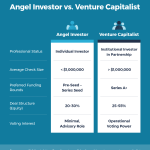What Documents Do I Need When I Pitch Venture Capitalists or Angel Investors
When preparing to pitch to venture capitalists or angel investors, having the right documents is crucial to making a strong impression and securing funding. These documents not only demonstrate your business’s potential but also showcase your professionalism and preparedness. From a well-crafted executive summary to detailed financial projections, each piece of documentation plays a vital role in building investor confidence. Understanding what to include and how to present it can significantly impact the outcome of your pitch. This article outlines the essential documents you need to prepare, ensuring you are fully equipped to present your business idea effectively and increase your chances of success.
What Documents Do I Need When I Pitch Venture Capitalists or Angel Investors?
When pitching to venture capitalists (VCs) or angel investors, having the right documents is crucial to making a strong impression and demonstrating your preparedness. These documents not only showcase your business idea but also provide evidence of your market potential, financial health, and growth strategy. Below, we break down the essential documents you need and why they matter.
See Also Why is It So Hard to Find an Angel Investor for My Startup?
Why is It So Hard to Find an Angel Investor for My Startup?1. Executive Summary
The executive summary is a concise overview of your business plan. It should highlight your value proposition, target market, revenue model, and key milestones. This document is often the first thing investors read, so it must be compelling and clear. Keep it to one or two pages, focusing on the most critical aspects of your business.
2. Business Plan
A detailed business plan is essential for showcasing your long-term vision. It should include sections on market analysis, competitive landscape, marketing strategy, operational plan, and financial projections. Investors use this document to assess the viability and scalability of your business. Make sure it is well-researched and data-driven.
See AlsoWhat Does It Take to Get Vc Funding?3. Pitch Deck
The pitch deck is a visual presentation that accompanies your verbal pitch. It typically includes 10-15 slides covering your problem statement, solution, market opportunity, business model, traction, team, and financials. The pitch deck should be visually appealing and easy to understand, with minimal text and strong visuals.
4. Financial Statements and Projections
Investors will want to see your financial statements, including income statements, balance sheets, and cash flow statements. Additionally, provide financial projections for the next 3-5 years, showing expected revenue, expenses, and profitability. These documents help investors gauge your financial health and growth potential.
See Also What Are the Most Interesting Vc and Angel Investors Blogs?
What Are the Most Interesting Vc and Angel Investors Blogs?5. Cap Table
A cap table (capitalization table) outlines the ownership structure of your company. It shows the equity held by founders, investors, and employees. This document is crucial for investors to understand how much equity they will receive in exchange for their investment and how their shares might dilute over time.
| Document | Purpose |
|---|---|
| Executive Summary | Provides a quick overview of your business. |
| Business Plan | Details your long-term strategy and market potential. |
| Pitch Deck | Visual presentation to support your verbal pitch. |
| Financial Statements | Shows current financial health and future projections. |
| Cap Table | Outlines ownership and equity distribution. |
How to pitch to angel investors?

 What is the Difference Between a Joint Venture Jv and a Special Purpose Vehicle Spv
What is the Difference Between a Joint Venture Jv and a Special Purpose Vehicle SpvUnderstanding Angel Investors and Their Expectations
Angel investors are typically high-net-worth individuals who provide capital for startups in exchange for equity or convertible debt. They often seek high-growth potential and a clear path to profitability. To pitch effectively, you must understand their motivations, which include:
- Financial returns: They aim for significant ROI, often looking for 10x returns.
- Passion for innovation: Many angel investors are drawn to groundbreaking ideas or industries they are passionate about.
- Mentorship opportunities: Some enjoy guiding startups and sharing their expertise.
Crafting a Compelling Pitch Deck
A well-structured pitch deck is essential to capture an angel investor's interest. It should be concise, visually appealing, and highlight the most critical aspects of your business. Key elements to include are:
- Problem statement: Clearly define the problem your product or service solves.
- Solution: Explain how your offering addresses the problem uniquely.
- Market opportunity: Showcase the size and growth potential of your target market.
- Business model: Outline how your company will generate revenue.
- Traction: Provide evidence of progress, such as sales, partnerships, or user growth.
Perfecting Your Elevator Pitch
An elevator pitch is a brief, persuasive speech that sparks interest in your business. It should be delivered in under 60 seconds and include:
- Start with a strong hook that grabs attention.
- Problem and solution: Quickly explain the problem and how your business solves it.
- Market potential: Highlight the size and opportunity of your market.
- Call to action: End with a clear request, such as a meeting or follow-up.
Demonstrating Traction and Milestones
Angel investors want to see evidence that your business is gaining momentum. To demonstrate traction, focus on:
- Revenue growth: Show consistent or increasing sales figures.
- User acquisition: Highlight the number of customers or users and their engagement.
- Partnerships: Mention any strategic alliances or collaborations.
- Product development: Share updates on product launches or improvements.
- Media coverage: Include any press or recognition your business has received.
Building a Strong Relationship with Investors
Angel investors often invest in people as much as ideas. To build trust and rapport, consider the following:
- Transparency: Be honest about challenges and risks.
- Communication: Keep investors updated regularly, even after the pitch.
- Alignment of values: Ensure your vision aligns with the investor's goals.
- Respect their time: Be concise and prepared during interactions.
- Show gratitude: Acknowledge their interest and feedback.
What documents do you give investors?

Business Plan
A business plan is one of the most critical documents provided to investors. It outlines the company's vision, mission, and strategic goals. The document typically includes:
- Executive Summary: A concise overview of the business and its objectives.
- Market Analysis: Insights into the target market, competition, and industry trends.
- Financial Projections: Detailed forecasts of revenue, expenses, and profitability.
Financial Statements
Investors require financial statements to assess the company's financial health. These documents include:
- Balance Sheet: A snapshot of the company's assets, liabilities, and equity.
- Income Statement: A report on revenue, expenses, and net income over a specific period.
- Cash Flow Statement: Details on cash inflows and outflows, highlighting liquidity.
Pitch Deck
A pitch deck is a visual presentation that summarizes the business plan. It typically includes:
- Problem Statement: The issue the business aims to solve.
- Solution: How the company addresses the problem.
- Market Opportunity: The size and potential of the target market.
Cap Table
A cap table (capitalization table) provides a breakdown of the company's ownership structure. It includes:
- Shareholders: Names and percentages of ownership.
- Equity Distribution: Details of shares issued, options, and warrants.
- Valuation: The company's current and projected valuation.
Term Sheet
A term sheet outlines the terms and conditions of the investment. Key components include:
- Investment Amount: The total funding being offered.
- Valuation: Pre-money and post-money valuation of the company.
- Rights and Obligations: Investor rights, such as voting rights and liquidation preferences.
What do you need to present to an angel investor?
1. A Clear and Compelling Business Idea
When presenting to an angel investor, the first thing you need is a clear and compelling business idea. This should outline the problem your product or service solves and why it is unique. Ensure your idea is easy to understand and demonstrates potential for growth.
- Define the problem your business addresses.
- Explain how your solution is unique and innovative.
- Highlight the market opportunity and potential for scalability.
2. A Detailed Business Plan
A detailed business plan is essential to show the investor that you have a roadmap for success. This should include your business model, revenue streams, and operational strategy.
- Provide a comprehensive business model.
- Outline your revenue streams and pricing strategy.
- Include a timeline for key milestones and goals.
3. Financial Projections and Metrics
Angel investors want to see financial projections that demonstrate the potential for a strong return on investment. Include realistic revenue forecasts, expense estimates, and key financial metrics.
- Present revenue forecasts for the next 3-5 years.
- Include expense estimates and break-even analysis.
- Highlight key metrics like customer acquisition cost and lifetime value.
4. A Strong Team and Expertise
Investors often bet on the team as much as the idea. Showcase your team’s expertise, experience, and ability to execute the business plan.
- Highlight the background and skills of your team members.
- Showcase any relevant industry experience.
- Demonstrate your team’s commitment and passion for the project.
5. A Clear Ask and Use of Funds
Be specific about how much funding you need and how you plan to use it. A clear ask shows that you have a well-thought-out plan for the investment.
- Specify the amount of funding you are seeking.
- Break down how the funds will be allocated (e.g., product development, marketing, hiring).
- Explain how the investment will help you achieve key milestones.
Frequently Asked Questions (FAQs)
What is the most important document to prepare when pitching to venture capitalists or angel investors?
When pitching to venture capitalists or angel investors, the most important document is your executive summary. This document provides a concise overview of your business, including your mission, product or service, target market, business model, and financial projections. It should be clear, compelling, and no longer than two pages. Investors often use the executive summary to decide whether they want to dive deeper into your pitch, so make sure it highlights your unique value proposition and growth potential.
Do I need a business plan when pitching to investors?
While not always required, having a detailed business plan can significantly strengthen your pitch. A business plan demonstrates that you have thoroughly thought through your business strategy, market opportunity, and operational plan. It typically includes sections on market analysis, competitive landscape, marketing strategy, and financial forecasts. Even if investors don’t ask for it upfront, having a business plan ready shows professionalism and preparedness, which can build trust and credibility.
What financial documents should I include in my pitch?
Financial documents are critical when pitching to investors. At a minimum, you should include a profit and loss statement, cash flow statement, and balance sheet. Additionally, provide a financial forecast that outlines your expected revenue, expenses, and profitability over the next three to five years. Investors will also want to see your burn rate (how quickly you’re spending money) and runway (how long your current funds will last). These documents help investors assess the financial health and growth potential of your business.
Should I include a pitch deck when approaching investors?
Yes, a pitch deck is essential when approaching investors. It is a visual presentation that complements your executive summary and business plan. A well-crafted pitch deck should include slides on your problem statement, solution, market size, product or service, business model, traction, team, and financials. Keep it concise, typically between 10-15 slides, and focus on telling a compelling story that highlights why your business is a worthwhile investment. A strong pitch deck can make a lasting impression and help you stand out in a competitive funding landscape.
Leave a Reply


Our Recommended Articles